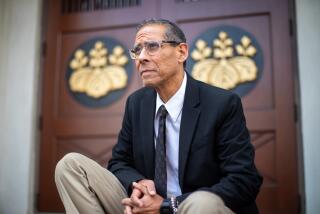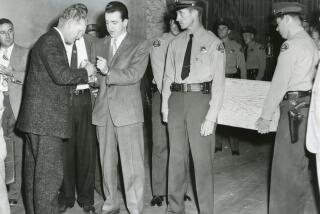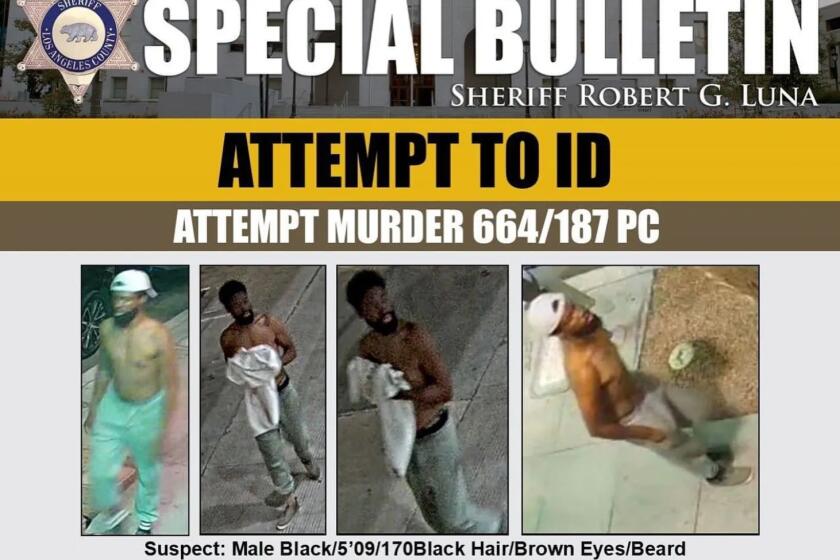
At the Long Beach drugstore counter where she liked to linger, a jobless young woman named Elizabeth Short acquired the playful nickname that would fuel her long, macabre afterlife. She dyed her hair jet black, matching the funereal hue of the clothes she favored. The Black Dahlia, people called her, riffing on a Raymond Chandler noir motion picture called “The Blue Dahlia.”
After Short’s mutilated body was found on Jan. 15, 1947, in a weedy lot in South Los Angeles, cops and reporters found her hangouts and learned her nickname. It made her sound like some kind of rare, poisonous bloom, a night creature on intimate terms with death.

There’s no proof she even knew of the nickname. It derived from noir fantasy and helped transform her into noir fantasy. Writers tailored her story to fit a femme fatale archetype. She was often described as an aspiring actress, and her death played as a cautionary tale parents might tell daughters who dreamed of taking a bus to Hollywood to find stardom.
The myths continue to swirl around Elizabeth Short, whose death at 22 has spawned endless byzantine theories. As with Jack the Ripper, an evocative moniker, an undercurrent of sex, outsize savagery and a lack of resolution combined to fuel enduring fascination. It remains L.A.’s most famous unsolved murder.
Born in Boston, a child of the Depression, Short came to Southern California not to pursue film stardom but a paramour. When that affair ended, she drifted between neighborhoods and temporary friendships. At one point, she had an aspiring actress for a housemate and appropriated that woman’s anecdotes as her own.
In this series, Christopher Goffard revisits old crimes in Los Angeles and beyond, from the famous to the forgotten, the consequential to the obscure, diving into archives and the memories of those who were there.
She invented endless stories to gain sympathy. Sometimes she was a war widow; sometimes she had lost a child.

She liked military men and dated officers, not enlisted men. She used candle wax to fill her cavities, which people did when they couldn’t afford a dentist. She cadged meals and rides and slept in an all-night movie theater.
She had no permanent address when a traveling salesman picked her up in San Diego in January 1947 and drove her to the bus station in downtown Los Angeles, where she dropped off her suitcases. He then left her at the Biltmore Hotel — she had lied and said she was meeting her sister there.
Her body was spotted a few days later by a woman pushing a stroller down Norton Avenue in Leimert Park. At first, police thought it was a mannequin. The mouth was sliced ear to ear, and the body was naked, posed flat on her back, drained of blood and in two parts, neatly severed between the second and third lumbar vertebrae. The lead detective suspected a practiced surgical hand.
At the time, four Los Angeles newspapers competed fiercely for scoops. The Examiner transmitted the victim’s fingerprints to the FBI to determine her name. (Short’s prints were on file because she had been arrested in Santa Barbara for underage drinking a few years earlier.) To elicit background information, an Examiner reporter then called Short’s mother with the cruel ruse that her daughter had won a beauty contest.
Police learned that Short had had brief encounters with many men, who almost unanimously maintained the encounters had been nonsexual. The lead detective would describe her as “a tease,” adding: “She probably went too far this time, and just set some guy off into a blind, berserk rage.”

The admixture of disapproval and disdain extended to popular accounts. “She was a lazy girl and irresponsible,” wrote Jack Webb in “The Badge.” “At twenty-one, when she should have been starting married life or maybe a modest career, she was already obsolescent.”
Webb’s book, published in 1958, suggested Short’s hold on the imagination a decade after her death.
“To the sociologist, she is the typical, unfortunate depression child who matured too suddenly in her teens into the easy money, easy living, easy loving of wartime America,” Webb wrote. To the criminologist, “her tortured, severed body is an eerie blend of Poe and Freud.”
Short’s murder highlighted attitudes about the transformation of American women, who had found independence in the World War II economy and expected to keep it.
“One of the biggest characters that influences the mythos of this case is postwar Los Angeles,” said Anne Redding, who teaches the case at Santa Barbara City College. “There was a backlash to the whole Rosie the Riveter movement. Women were supposed to go back to being wives and moms. I think that heavily influenced the misogyny.”

Redding sees a sign of Short’s independence in the rose tattoo on her leg — an uncommonly daring gesture in the 1940s. “There was a little bit of edge play going on,” she said. Short was “striking out on a whim without much of a plan.”
Redding tries to show students the ways that Short’s past made her vulnerable. How her father abandoned her family when she was 6. How terrible asthma curtailed her education. How she never recovered from the 1945 death of a military pilot she loved, which seemed to initiate a “progressive degeneration of her ability to cope with the world and take care of herself.”
Short had worked as a waitress and cashier, but “there’s no record that she ever had another job” after his death in a plane crash. “Her nomadic nature accelerated,” Redding said.
When Short left the Biltmore Hotel, it’s possible she was heading back to the bus station, where it was safer to pass the night on a bench than on the streets.
“Wherever she went, she was alone. She was literally homeless. She had no one,” Redding said. “She was a relatively attractive young woman. She was a compulsive liar. She was known to approach strangers for favors. Whether you could call her intentionally manipulative, or, to be more generous, dangerously trusting, she was a high-risk victim in a high-risk situation.”
Larry Harnisch, a retired Los Angeles Times copy editor, is now arguably the world’s top authority on the case. The battle for accuracy against the “true crime industrial complex” is never-ending. It would be easy to spend all day, every day, fighting off the crackpot theories of what the novelist James Ellroy has called “Dahlia freaks.”
In myth, Short was an aspiring starlet “sleeping her way across Tinseltown ... the starstruck moth who comes to Hollywood and gets burned by the Hollywood flame” and “finds in death the fame she didn’t find in life,” as Harnisch puts it.
In reality, Harnisch says, she never took an acting class, never registered in Central Casting and never lost the Boston accent that would have limited her roles.
Harnisch began researching the case seriously in the late 1990s, for a 50th anniversary story. He does not believe there is a single factually reliable book about it.

In Piu Eatwell’s “Black Dahlia Red Rose,” the killer is a bellhop named Leslie Dillon. (“He didn’t do it,” Harnisch says. “He was in San Francisco. If [Eatwell] had talked to me for five minutes, I would have said, ‘That’s bulls—.’ ”)
In John Gilmore’s “Severed,” the killer is Jack Wilson, a Skid Row alcoholic. (Harnisch calls the book “25% mistakes and 50% fiction.”)
In Steve Hodel’s “Black Dahlia Avenger,” the killer is the author’s father, George Hodel, a doctor who ran a venereal disease clinic. (“It’s crap. It’s fabricated.”)
In Donald H. Wolfe’s “The Black Dahlia Files,” the killer is gangster Bugsy Siegel, acting at the behest of L.A. Times publisher Norman Chandler, who (allegedly) impregnated Short and wanted her out of the way. (“Ridiculous, painfully stupid.”)
In another book, a woman claims she saw her father kill Short but repressed the memory for years. Another author fingers filmmaker Orson Welles (linked to the slaying because he sawed an assistant in two in a magic act).
“People are so nuts,” Harnisch says. “People don’t want the record set straight. People want this grab bag of noir tropes.”
Harnisch has his own favorite suspect. John Douglas, the former FBI profiler, told him there was meaning in where Short’s body was found. The killer could have dumped the body in the desert or the mountains but chose a much-traveled stretch of Norton Avenue. Probably the killer had a link to the area and wanted to “put the fear of God” in its residents.
Harnisch found something generations of detectives had missed: Short had a connection to the neighborhood. Her sister knew a surgeon named Walter Bayley, whose estranged wife lived a block from the crime scene.

If you have information on old crimes, famous, once-famous or obscure, contact [email protected]
Bayley was 66 and suffering from a brain lesion that had dramatically changed his personality. His office was blocks from the Biltmore.
Maybe a destitute Short had emerged from the Biltmore that night and sought his help … maybe she told the sob story about losing a child, not knowing that Bayley’s own son actually had been killed by a truck … maybe this enraged him …
Bayley died a year after Short’s murder. The Times was unable to locate any living relatives.

“Bayley had the skill to do what was done to her,” Harnisch said. “He’s not a perfect suspect, but he checks more boxes than anyone else. I always hedge.”
Harnisch is at work on his own Dahlia book. It’s 156,000 words and growing.
David Lambkin, a retired detective, said the physical evidence was nearly nonexistent by the time he examined the case as head of the LAPD’s Cold Case Unit in 2001.
He said it is unlikely ever to be solved. He is familiar with the books and the suspects they propose.
“Very few have anything going for them,” he said. “My favorite is Larry Harnisch’s theory. Harnisch could actually connect his suspect to that location.”
More to Read
Subscriber Exclusive Alert
If you're an L.A. Times subscriber, you can sign up to get alerts about early or entirely exclusive content.
You may occasionally receive promotional content from the Los Angeles Times.













